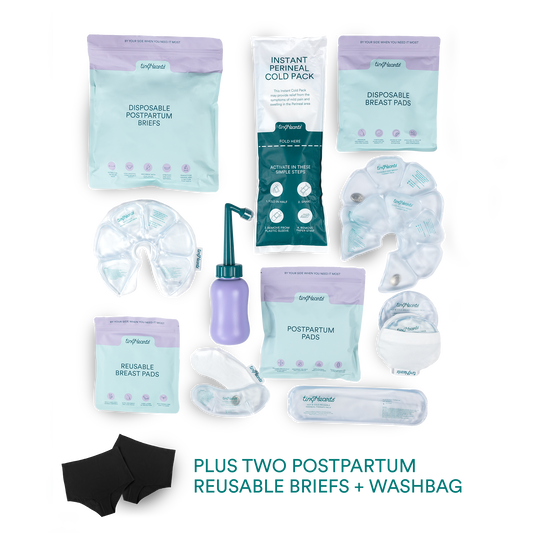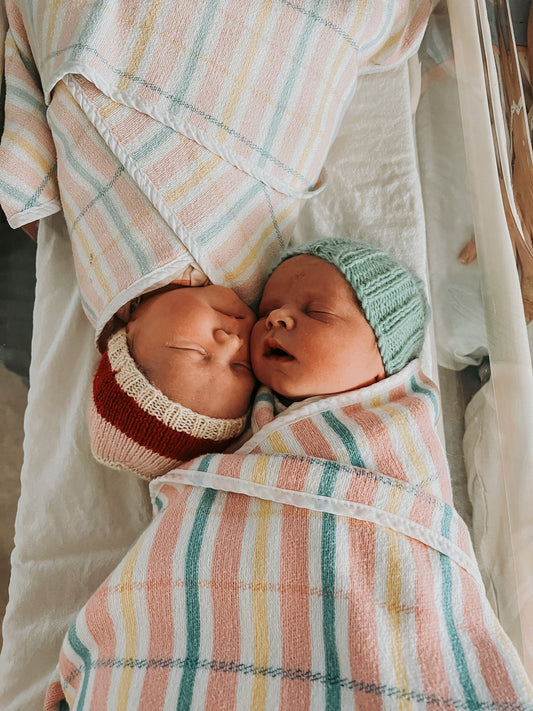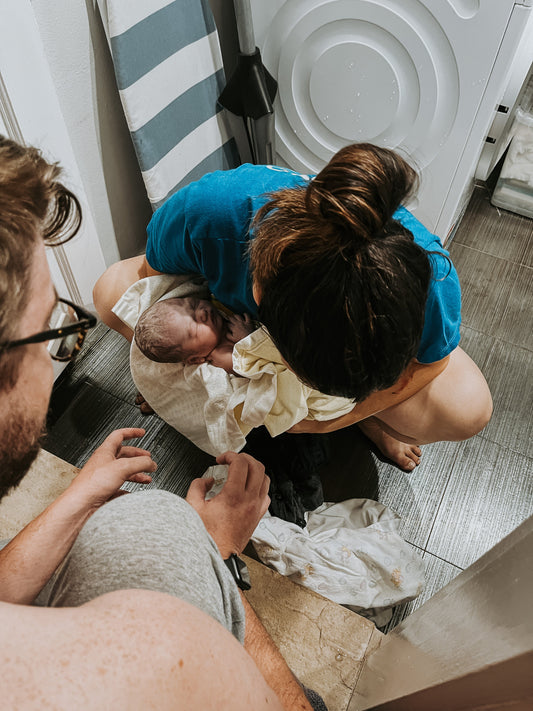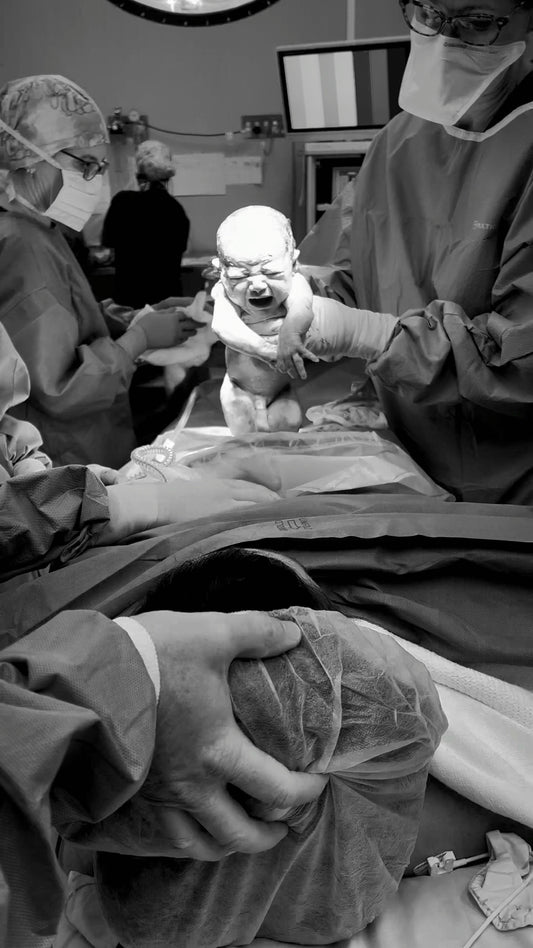When you've got a little one on the way, there's a tonne to think about, including what you'll need to get for them. When it's time to start shopping, it can be pretty overwhelming with all the stuff that seems like must-haves. But here are some suggestions (from an experienced Mum and Midwife!) for new parents who might be unsure about what's essential and what's just nice to have when it comes to getting ready for a little one.
The Essentials
A Rear-Facing Car Seat
By law, all infants must be rear-facing until at least six months of age but can remain rear-facing in a correctly fitting car seat until four years. It's also a requirement that they meet the guidelines on the car seat that include statements like "must be rear-facing when shoulders are below this line". Rear-facing is recommended for as long as possible for little ones, as it's reported to be much safer by supporting the head and neck in an accident compared to forward-facing. For this reason, we recommend choosing an extended rear-facing car seat to maximise the amount of time baby is rear-facing. When rear-facing, the shoulder straps should be at or slightly above your little one's shoulders but never below [Australian recommendations].
The alternative is a capsule, which also rear-faces like a car seat. Capsules can also be clicked onto some prams, taken out of the car seat, and brought inside. Bubs usually last around 10-12 months before growing out of the capsule, at which point they will require an age-appropriate car seat. Most importantly, many parents buy capsules to allow bub to fall asleep in the capsule, then be able to bring them inside and leave them still asleep in the capsule. Whilst convenient, this is not recommended.
If little ones are left in a sitting position for long periods of time, their SIDS risk is increased, so Red Nose recommends not leaving little ones in a car seat or capsule for more than 2 hours without a break, particularly if sleeping. They also recommend taking your little one out of their car seat or capsule when you arrive at your destination, even if that means they'll wake up to reduce their amount of time in a sitting position. Plus, falls from capsules used outside of the car, like when put into shopping trolleys or on bench tops, are common and may lead to a serious head injury.
So, if you do choose to use a capsule, keep it for the car and pram, and take the baby out of it once you arrive at your destination, as you would a car seat.

A Cot
When your little one is born, they're going to need a safe sleep space, such as a cot or bassinet. This is what Red Nose recommends when it comes to creating a safe sleep space:
- Put bub on their back to sleep, at every sleep
- Sleep baby in a cot in your room for the first 6-12 months of life
- Sleep your little one alone in the cot with no toys, loose bedding or cot bumpers
- Choose a sleeping bag TOG that matches the temp of baby's room.
- If you use a sleeping bag, check the sleeping bag is fitted, making sure they can't wriggle down inside the neck part of the sleeping bag.
- Use hood-free sleeping bags.
- There is no set temperature that bub's room should be set at to reduce the likelihood of SIDS, or that a heater or aircon is used all night as long as bub is dressed appropriately to the conditions of the room.
- Your baby can sleep in a bassinette until they show signs of rolling
- Bub can be swaddled for sleep [it helps them settle] until they show signs of rolling
- Some research suggests using a fan in your baby's room reduces their SIDS risk
- Tuck in any blankets securely and make sure they can only reach up to their chest to avoid them wriggling down underneath.
- Avoid using any devices that are designed to keep your little love in a certain position.
- Wrap your little one using lightweight cotton or muslin wraps rather than thick or fluffy blankets.
- If you choose to co-sleep, educate yourself on how to do it safely [more info on the Red Nose website]
- Avoid co-sleeping in unsafe places, such as the lounge or an armchair
A Pram
While some may not, I consider a pram an essential item. Why? It's a safe place you can put your newborn when out and about. It can protect them from the elements, it can help to rock them to sleep, and it allows you the freedom to go places without having to carry them, especially if you're still recovering from birth. You can also get lots of add-ons like mozzie nets to keep your little one safe when mozzies are about. My top tips on choosing a pram:
- Make sure you can fold it by yourself easily
- Make sure it fits in the boot of your car
- Make sure it meets the Australian safety standards for prams
- Is easy for you to push comfortably
- Offers bub a lot of shade
- Is comfortable for bub
- Can be reclined
- Has some storage [you'll need that to store their snacks once they're a toddler]
Nappies & Wipes
On the first day of life, we expect baby to have at least one wet nappy. On day 2, we expect at least two wet nappies. Day 3 = 3 wet nappies, and so on until day 5. From day 5, we expect your newborn to have at least 6-8 wet cloth nappies or 5-7 disposable nappies in 24 hours that are light in colour and don't smell. That doesn't even include their dirty nappies, which can come quite frequently [may occur as often as every feed for BF babes]. As you can see, you're going to use a lot of nappies and wipes in the early days, so stock up before the baby comes, regardless of whether you're choosing to use cloth or disposable nappies and cloth or disposable wipes.

Clothes for Baby
Buying and choosing clothes for your little one is one of the most exciting parts! As a general rule, dress them in what you're wearing +1 layer.
If the weather is cool outside, dress them in multiple layers or use a higher TOG swaddle rather than one layer of thick and bulky clothing. That way, you can remove or add layers overnight as needed if the bub gets too hot or cold.
When indoors, sleeping, in prams and in the car seat, avoid hats and beanies and keep baby's face uncovered. When little ones get hot, their bodies blow off that extra heat through their head and face. If they've got a hat or beanie on in these locations, or their face is covered, that heat can get trapped, leading to overheating [SIDS risk]. There's also a suffocation risk if beanies or headbands cover their nose and mouth.
To monitor bub's temp in clothing, use an underarm thermometer or feel their back or belly because feeling the hands and feet doesn't give you a true representation of their temperature and may often feel cold due to immature circulation.
Lots of parents bring 000 size clothing to the hospital. In my experience, most newborns fit in a 00000 or 0000. The few bubs I have seen that fit well in a 000 at birth were 4.3kg+. Also, try to avoid buying lots of 0000 and 00000-sized clothing. Newborns grow so quickly, so while you will need spare in case of poo-explosions, milk spills or spit-up, you don't need lots and lots of clothing in these sizes.
Muslin Wraps for Swaddling
Swaddling your baby has many benefits, including:
- Helping them settle
- Overcoming their natural startle reflex [which can wake them up]
- Linking sleep cycles [this is a theory which is based on keeping them settled and minimising the startle reflex]
- Help little one feel secure while sleeping
There are a few ways you can swaddle bub using a muslin wrap. It's recommended that the baby stops swaddling and moves to an arms-free sleeping bag as soon as they shows signs of being able to roll, which is usually sometime around 12 weeks of age. You also need to be mindful that the swaddle isn't so tight that it impacts their hip development and still allows them to stay in a natural position.
A Thermometer
Any temperature of 38 degrees or above in a little one under three months old is not normal and indicates that your newborn needs immediate medical attention. To take your baby's temperature, place a thermometer under their arm. We don't recommend taking bub's temperature in the ear until they're older. While you don't need to routinely take bub's temp each day if they feel warm, is showing signs of being unwell, you think they may have a fever, or you've been instructed to do so by their medical team, you will need an underarm [axilla] thermometer to take their temp. Don't forget to record the date and time of the temperature reading, too.
If Formula Feeding: Bottles, Formula and Steriliser
Some parents choose to formula feed their bub from birth. Some decide to mix feed [breast and formula feed]. If this is you, it's a good idea to have bottles, formula, and a steriliser ready to go at home so you don't have to frantically run around and get everything once your baby has arrived.
Bottles and teats containing formula need to be rinsed and sterilised after every feed, which is why you need a steriliser [you can get microwavable ones or sterilisers that go on the bench top]. You'll also need bottles and newborn teats to make sure the milk flow is slow enough for them to drink comfortably. Teats need to be replaced every three months, but this usually coincides with when they may be ready to move up to the next flow speed [watch bub's cues as you don't always have to move up, they may enjoy that milk flow speed].
You'll also need to choose a formula and have a tin of Stage 1 formula ready to go. Due to the stringent requirements here in Australia, all cow's milk-based formulas meet strict standards and are of similar quality and nutritional value. So don't get too caught up in this! Note that the 'follow-on' formula is a bit of a gimmick; you can pick one formula and use it until bub is 1, at which point you can transition to solids and Cow's Milk and/or water.

Nice To Have
A Baby Carrier
A baby carrier is used for babywearing. Babywearing is the broad term used to describe when bub is held by a wrap, sling or carrier against a parent's chest. I've said it before, I'll say it again: you can't spoil your baby by attending to them. If your little one is telling you that they want to be held close to you in a carrier, wrap or sling, then do it. It will help you, and it will comfort bub.
And if you need another reason to baby wear, here are nine:
- Babywearing reduces crying and fussiness by up to 51% and reduces bub's levels of stress hormones. That's AMAZING!
- It lets busy parents be hands-free to chase toddlers, hang some washing, throw down some lunch or do whatever they need to do.
- Your little one will be exposed to a wide variety of stimulation while worn, leading to brain development.
- The physical and psychological benefits associated with babywearing encourage a baby's sense of security, self-esteem and happiness.
- Babies who are worn have better sleep quality.
- The occurrence of postnatal depression is decreased in those who baby wear.
- It promotes bonding and helps with managing reflux symptoms.
- Having your newborn close allows parents to get to know their cues and respond early, which minimises crying time.
- Babies who are worn are shown to be not as clingy compared to babies who are held less frequently.
There are many types of baby carriers out there. Some baby carriers I know of that are approved by the International Hip Dysplasia Institute are Baby Bjorn, Baby Tula, Chekoh, Ergobaby, Hug-A-Bub, Kanga Wrap, Manduca, and Pognae. Whichever you choose, make sure you do your research to find one that suits your needs and is supported by the International Hip Dysplasia Institute.
A Bassinet
As discussed above, little ones need a safe space to sleep. As a little one will outgrow a bassinet as soon as they begin rolling [around 3-4months], you won't get as much use out of a bassinet as you will a cot, making this a 'nice to have' item. The good thing about bassinets is that they are easily mobile, whilst cots take a lot more work to move. This means that if you're doing something and want to supervise bub, who's having a snooze, it's easy for you to move the bassinet to wherever you need it to be. Some bassinets also have a side that drops down and can be attached to an adult bed, becoming like a side-sleeping cot, which is amazing for parents who want to co-sleep but not bed-share.
A Baby Swing
Babies love motion. In my experience, rocking, swinging them, patting them, etc., helps settle and calm them down. Whilst this is and can be easily done by parents, everyone needs a break sometimes, which is where baby swings come in. You can get a range of these, which vary in price. As amazing as they are, it's important to know that they're not a safe sleep space. So, by all means, use it to have a quick break, to settle bub, or even to help them get to sleep [once fed, changed, burped, etc.], but once they are asleep, they need to be transferred to a safe sleep space.

A Breathing Monitor
Breathing monitors are electronic devices that monitor your baby during their sleep. There are a few different types of breathing monitors:
- Owlet: a sock-style monitor that wraps onto baby's foot and monitors heart rate, oxygen saturation and if they're in a light or deep sleep. The device will alarm if little one goes outside of the preset ranges for both heart rate and oxygen saturation to wake you into action. If you have wifi, you can connect it to your device to see live readings. However, it's not cheap, and I don't like that you can't customise its "normal" ranges.
- Snuza: a monitor that uses motion detection by clipping onto little one's nappy to count breaths per minute, skin temperature and sleeping position. It also alerts if they stop breathing after 15 seconds, then alarms at 20 seconds. It can send live readings to your device using Bluetooth, and you can change the "normal" ranges of breaths. With this, there can be false alarms if it slips off baby's nappy, and it's not cheap either.
- Breathing pads: These work on motion detection under your baby's mattress and alert if breathing movement slows to <10 breaths/ minute or isn't detected for 20 secs. If they wriggle off, it may trigger a false alarm or may falsely detect breathing from an overhead fan.
It's important for any parents considering this to know that Red Nose tells us that currently, there's no research saying a breathing monitor will prevent SIDS. These devices don't save your bub's life if they stop breathing; they simply alert you to it. If it ever happened, you would still need to provide CPR until the ambulance arrived. So ask yourself, am I buying this to be alerted, or am I buying this to save my bub's life? If it's the latter, the device simply doesn't do that; only you can.
A Baby Monitor
Baby monitors are cameras that are usually placed near a baby's sleep space so that they can see and hear them when they're in another room sleeping. Whilst not essential, they provide peace of mind that you can check in on a bub anytime you like without sneaking into the room or risking waking them up. It's also useful if you're worried, and you won't hear them wake up crying if they're a few rooms away. Some of them can play music, allowing you to speak through it for them to hear and measure the temperature of the room, which is helpful to make sure baby is dressed appropriately for the conditions.
Swaddle Suits
If you can afford it, swaddle suits or sleeping bags are amazing, especially if you struggle to swaddle baby in the first place. You can buy different TOG ratings, meaning you can use them in all conditions. It also zips from both top and bottom, so you can change their nappy at night without stripping them off or unwrapping them completely, using just the bottom zip. While they're more expensive than regular swaddles, they are fab but also something you can do without if short on funds.
Bath Thermometers
When a little one has a bath, the water temp should be warm, but not hot, about 37-38 degrees. Some parents buy bath thermometers to ensure it's exactly this every time, and while it's helpful, it's not essential. You can also feel the water with the inside of your wrist.
I hope this takes out some of the confusion around what's essential and what's nice to have when it comes to little ones 🫶







